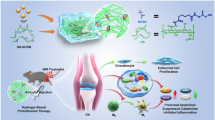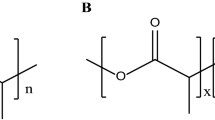Abstract
BMP-2 is currently administered clinically using collagen matrices often requiring large amounts of BMP-2 due to burst release over a short period of time. We developed and tested a novel injectable drug delivery system consisting of starch-poly-є-caprolactone microparticles for inducing osteogenesis and requiring smaller amounts of BMP-2. We evaluated BMP-2 encapsulation efficiency and the in vitro release profile by enzyme-linked immunosorbent assay. BMP-2 was rapidly released during the first 12 hours, followed by sustained release for up to 10 days. We then evaluated the osteogenic potential of dexamethasone (standard osteogenic induction agent) and BMP-2 after incorporation and during release using an osteo/myoblast cell line (C2C12). Alkaline phosphatase activity was increased by released BMP-2. Mineralization occurred after stimulation with BMP-2-loaded microparticles. A luciferase assay for osteocalcin promoter activity showed high levels of activity upon treatment with BMP-2-loaded microparticles. In contrast, no osteogenesis occurred in C2C12 cells using dexamethasone-loaded microparticles. However, human adipose stem cells exposed to the microparticles produced high amounts of alkaline phosphatase. The data suggest starch-poly-є-caprolactone microparticles are suitable carriers for the incorporation and controlled release of glucocorticoids and growth factors. Specifically, they reduce the amount of BMP-2 needed and allow more sustained osteogenic effects.









Similar content being viewed by others
References
Azevedo HS, Gama FM, Reis RL. In vitro assessment of the enzymatic degradation of several starch based biomaterials. Biomacromolecules. 2003;4:1703–1712.
Azevedo HS, Reis RL. Understanding the enzymatic degradation of biodegradable polymers and strategies to control their degradation rate. In: Reis RL, San Roman J, eds. Biodegradable Systems in Tissue Engineering and Regenerative Medicine. Boca Raton, FL: CRC Press; 2005:177–201.
Balmayor ER, Tuzlakoglu K, Azevedo HS, Reis RL. Preparation and characterization of starch-poly-ε-caprolactone microparticles incorporating bioactive agents for drug delivery and tissue engineering applications. Acta Biomater. 2009;5:1035–1045.
Balmayor ER, Tuzlakoglu K, Marques AP, Azevedo HS, Reis RL. A novel enzymatically-mediated drug delivery carrier for bone tissue engineering applications: combining biodegradable starch-based microparticles and differentiation agents. J Mater Sci Mater Med. 2008;19:1617–1623.
Bastioli C, Bellotti V, Montino A, Tredici GD, Lombi R, Ponti R; Novamont SpA (Milan, IT), assignee. Biodegradable polymeric compositions based on starch and thermoplastic polymers. US patent 5 412 005, May 2, 1995.
Bessa PC, Casal M, Reis RL. Bone morphogenetic proteins in tissue engineering: the road from the laboratory to the clinic, part I (basic concepts). J Tissue Eng Regen Med. 2008;2:1–13.
Bessa PC, Casal M, Reis RL. Bone morphogenetic proteins in tissue engineering: the road from laboratory to clinic, part II (BMP delivery). J Tissue Eng Regen Med. 2008;2:81–96.
Chen D, Zhao M, Mundy GR. Bone morphogenetic proteins. Growth Factors. 2004;22:233–241.
Chen FM, Wu ZF, Sun HH, Wu H, Xin SN, Wang QT, Dong GY, Ma ZW, Huang S, Zhang JJ, Jin Y. Release of bioactive BMP from dextran-derived microspheres: a novel delivery concept. Int J Pharm. 2006;307:23–32.
DeCoster TA, Gehlert R, Mikola EA, Pirela-Cruz MA. Management of posttraumatic segmental bone defects. J Am Acad Orthop Surg. 2004;12:28–38.
Demirgoz D, Elvira C, Mano JF, Cunha AM, Piskin E, Reis RL. Chemical modification of starch based biodegradable polymeric blends: effects on water uptake, degradation behaviour and mechanical properties. Polym Degrad Stab. 2000;70:161–170.
den Boer FC, Wippermann BW, Blokhuis TJ, Patka P, Bakker FC, Haarman H. Healing of segmental bone defects with granular porous hydroxyapatite augmented with recombinant human osteogenic protein-1 or autologous bone marrow. J Orthop Res. 2003;21:521–528.
Gersbach CA, Guldberg RE, Garcia AJ. In vitro and in vivo osteoblastic differentiation of BMP-2- and Runx2-engineered skeletal myoblasts. J Cell Biochem. 2007;100:1324–1336.
Gitelman SE, Kirk M, Ye JQ, Filvaroff EH, Kahn AJ, Derynck R. Vgr-1/BMP-6 induces osteoblastic differentiation of pluripotential mesenchymal cells. Cell Growth Differ. 1995;6:827–836.
Gomes ME, Reis RL, Mikos AG. Injectable polymeric scaffolds for bone tissue engineering. In: Reis RL, San Roman J, eds. Biodegradable Systems in Tissue Engineering and Regenerative Medicine. Boca Raton, FL: CRC Press; 2005:29–38.
Gugala Z, Gogolewski S. Healing of critical-size segmental bone defects in the sheep tibiae using bioresorbable polylactide membranes. Injury. 2002;33(Suppl 2):B71–B76.
Huang X, Brazel CS. On the importance and mechanisms of burst release in matrix-controlled drug delivery systems. J Control Release. 2001;73:121–136.
Jorgensen NR, Henriksen Z, Sorensen OH, Civitelli R. Dexamethasone, BMP-2, and 1,25-dihydroxyvitamin D enhance a more differentiated osteoblast phenotype: validation of an in vitro model for human bone marrow-derived primary osteoblasts. Steroids. 2004;69:219–226.
Katagiri T, Yamaguchi A, Ikeda T, Yoshiki S, Wozney JM, Rosen V, Wang EA, Tanaka H, Omura S, Suda T. The non-osteogenic mouse pluripotent cell line, C3H10T1/2, is induced to differentiate into osteoblastic cells by recombinant human bone morphogenetic protein-2. Biochem Biophys Res Commun. 1990;172:295–299.
Katagiri T, Yamaguchi A, Komaki M, Abe E, Takahashi N, Ikeda T, Rosen V, Wozney JM, Fujisawa-Sehara A, Suda T. Bone morphogenetic protein-2 converts the differentiation pathway of C2C12 myoblasts into the osteoblast lineage. J Cell Biol. 1994;127:1755–1766.
Keskin SD, Hasirci V. Controlled release of bioactive agents in gene therapy and tissue engineering. In: Elcin M, ed. Tissue Engineering, Stem Cells and Gene Therapies. New York, NY: Kluwer Academic/Plenum Publishers; 2003:279–296.
Kim HD, Valentini RF. Human osteoblast response in vitro to platelet-derived growth factor and transforming growth factor-beta delivered from controlled-release polymer rods. Biomaterials. 1997;18:1175–1184.
Kim IS, Song YM, Cho TH, Park YD, Lee KB, Noh I, Weber F, Hwang SJ. In vitro response of primary human bone marrow stromal cells to recombinant human bone morphogenic protein-2 in the early and late stages of osteoblast differentiation. Dev Growth Differ. 2008;50:553–564.
Kim SE, Park JH, Cho YW, Chung H, Jeong SY, Lee EB, Kwon IC. Porous chitosan scaffold containing microspheres loaded with transforming growth factor-beta 1: implications for cartilage tissue engineering. J Control Release. 2003;91:365–374.
Komaki H, Tanaka T, Chazono M, Kikuchi T. Repair of segmental bone defects in rabbit tibiae using a complex of beta-tricalcium phosphate, type I collagen, and fibroblast growth factor-2. Biomaterials. 2006;27:5118–5126.
Krause F, Younger A, Weber M. Recombinant human BMP-2 and allograft compared with autogenous bone graft for reconstruction of diaphyseal tibial fractures with cortical defects. J Bone Joint Surg Am. 2008;90:1168–1169.
Laurencin C, Khan Y, El-Amin SF. Bone graft substitutes. Expert Rev Med Devices. 2006;3:49–57.
Laurencin CT, Ambrosio AM, Borden MD, Cooper JA. Tissue engineering: orthopedic applications. Annu Rev Biomed Eng. 1999;1:19–46.
Lewis DH. Controlled release of bioactive agents from lactide/glycolide polymers. In: Chasin M, Langer R, eds. Biodegradable Polymers as Drug Delivery Systems. New York, NY: Marcel Dekker, Inc; 1990:1–42.
Lian JB, Stein GS. Concepts of osteoblast growth and differentiation: basis for modulation of bone cell-development and tissue formation. Crit Rev Oral Biol Med. 1992;3:269–305.
Luppen CA, Chandler RL, Noh T, Mortlock DP, Frenkel B. BMP-2 vs. BMP-4 expression and activity in glucocorticoid-arrested MCM-E1 osteoblasts: Smad signaling, not alkaline phosphatase activity, predicts rescue of mineralization. Growth Factors. 2008;26:226–237.
Marques AP, Reis RL, Hunt JA. The biocompatibility of novel starch-based polymers and composites: in vitro studies. Biomaterials. 2002;23:1471–1478.
Medscape. New bone graft techniques and applications in the spine. Available at: http://cme.medscape.com/viewarticle/443902_2. Accessed May 23, 2009.
Meinel L, Illi OE, Zapf J, Malfanti M, Merkle HP, Gander B. Stabilizing insulin-like growth factor-I in poly(D,L-lactide-co-glycolide) microspheres. J Control Release. 2001;70:193–202.
Mendes SC, Reis RL, Bovell YP, Cunha AM, van Blitterswijk CA, de Bruijn JD. Biocompatibility testing of novel starch-based materials with potential application in orthopaedic surgery: a preliminary study. Biomaterials. 2001;22:2057–2064.
Morsczeck C, Moehl C, Gotz W, Heredia A, Schaffer TE, Eckstein N, Sippel C, Hoffmann KH. In vitro differentiation of human dental follicle cells with dexamethasone and insulin. Cell Biol Int. 2005;29:567–575.
Patel ZS, Yamamoto M, Ueda H, Tabata Y, Mikos AG. Biodegradable gelatin microparticles as delivery systems for the controlled release of bone morphogenetic protein-2. Acta Biomater. 2008;4:1126–1138.
Perka C, Schultz O, Spitzer RS, Lindenhayn K, Burmester GR, Sittinger M. Segmental bone repair by tissue-engineered periosteal cell transplants with bioresorbable fleece and fibrin scaffolds in rabbits. Biomaterials. 2000;21:1145–1153.
Perry CR. Bone repair techniques, bone graft, and bone graft substitutes. Clin Orthop Relat Res. 1999;360:71–86.
Reis RL, Cunha AM. Starch Polymers. In: Buschow KHJ, Cahn RW, Flemings MC, Ilschner B, Kramer EJ, Mahajan S, Veyssiere P, eds. Encyclopedia of Materials: Science and Technology. Vol 11. New York, NY: Elsevier Ltd; 2001:8810–8816.
Reis RL, Mendes SC, Cunha AM, Bevis MJ. Processing and in vitro degradation of starch/EVOH thermoplastic blends. Polym Int. 1997;43:347–352.
Rickard DJ, Sullivan TA, Shenker BJ, Leboy PS, Kazhdan I. Induction of rapid osteoblast differentiation in rat bone-marrow stromal cell-cultures by dexamethasone and BMP-2. Dev Biol. 1994;161:218–228.
Rose FR, Hou Q, Oreffo RO. Delivery systems for bone growth factors: the new players in skeletal regeneration. J Pharm Pharmacol. 2004;56:415–427.
Salehian B, Mahabadi V, Bilas J, Taylor WE, Ma K. The effect of glutamine on prevention of glucocorticoid-induced skeletal muscle atrophy is associated with myostatin suppression. Metabolism. 2006;55:1239–1247.
Salgado AJ, Coutinho OP, Reis RL. Novel starch-based scaffolds for bone tissue engineering: cytotoxicity, cell culture, and protein expression. Tissue Eng. 2004;10:465–474.
Sampath TK, Maliakal JC, Hauschka PV, Jones WK, Sasak H, Tucker RF, White KH, Coughlin JE, Tucker MM, Pang RH, et al. Recombinant human osteogenic protein-1 (hOP-1) induces new bone formation in vivo with a specific activity comparable with natural bovine osteogenic protein and stimulates osteoblast proliferation and differentiation in vitro. J Biol Chem. 1992;267:20352–20362.
Silva GA, Coutinho OP, Ducheyne P, Shapiro IM, Reis RL. Starch-based microparticles as vehicles for the delivery of active platelet-derived growth factor. Tissue Eng. 2007;13:1259–1268.
te Pas MFW, de Jong PR, Verburg FJ. Glucocorticoid inhibition of C2C12 proliferation rate and differentiation capacity in relation to mRNA levels of the MRF gene family. Mol Biol Rep. 2000;27:87–98.
Uludag H, Gao T, Porter TJ, Friess W, Wozney JM. Delivery systems for BMPs: factors contributing to protein retention at an application site. J Bone Joint Surg Am. 2001;83(Suppl 1 Pt 2):S128–S135.
Urist MR, Silverman BF, Büring K, Dubuc FL, Rosenberg JM. The bone induction principle. Clin Orthop Relat Res. 1967;53:243–283.
Wang SB, Chen AZ, Weng LJ, Chen MY, Xie XL. Effect of drug-loading methods on drug load, encapsulation efficiency and release properties of alginate/poly-L-arginine/chitosan ternary complex microcapsules. Macromol Biosci. 2004;4:27–30.
Wildemann B, Kadow-Romacker A, Pruss A, Haas NP, Schmidmaier G. Quantification of growth factors in allogenic bone grafts extracted with three different methods. Cell Tissue Bank. 2007;8:107–114.
Yamaguchi A, Katagiri T, Ikeda T, Wozney JM, Rosen V, Wang EA, Kahn AJ, Suda T, Yoshiki S. Recombinant human bone morphogenetic protein-2 stimulates osteoblastic maturation and inhibits myogenic differentiation in vitro. J Cell Biol. 1991;113:681–687.
Yamaguchi A, Komori T, Suda T. Regulation of osteoblast differentiation mediated by bone morphogenetic proteins, hedgehogs, and Cbfa1. Endocr Rev. 2000;21:393–411.
Yamamoto N, Furuya K, Hanada K. Progressive development of the osteoblast phenotype during differentiation of osteoprogenitor cells derived from fetal rat calvaria: model for in vitro bone formation. Biol Pharm Bull. 2002;25:509–515.
Yeo Y, Park K. Control of encapsulation efficiency and initial burst in polymeric microparticle systems. Arch Pharm Res. 2004;27:1–12.
Acknowledgments
We thank Ms. Daniela Dopler for expert technical assistance during the in vitro cell culture experiments.
Author information
Authors and Affiliations
Corresponding author
Additional information
One or more authors have received funding from a personal grant of Marie Curie Host Fellowships for Early Stage Research Training (EST) “Alea Jacta EST” (MEST-CT-2004-008104) (ERB) and from the European NoE EXPERTISSUES (NMP3-CT-2004-500283) (RLR).
This work was performed at 3B′s Research Group–Biomaterials, Biodegradables and Biomimetics (material development and characterization, as well as in vitro BMP-2 release studies including the testing of encapsulation efficiency) and at the Ludwig Boltzmann Institute for Experimental and Clinical Traumatology (in vitro cell studies).
About this article
Cite this article
Balmayor, E.R., Feichtinger, G.A., Azevedo, H.S. et al. Starch-poly-є-caprolactone Microparticles Reduce the Needed Amount of BMP-2. Clin Orthop Relat Res 467, 3138–3148 (2009). https://doi.org/10.1007/s11999-009-0954-z
Received:
Accepted:
Published:
Issue Date:
DOI: https://doi.org/10.1007/s11999-009-0954-z




